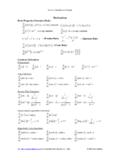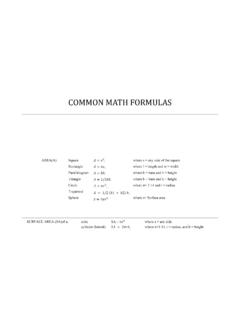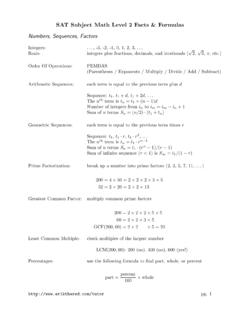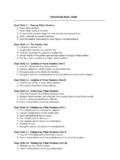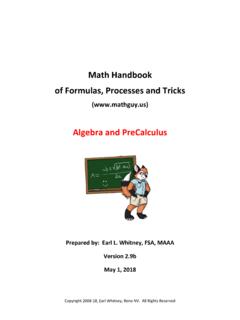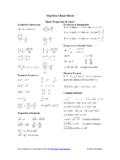Transcription of Common Core State Standards Math – Standards …
1 2012 Noyce Foundation Performance Assessment Task Gym Grade 6 This task challenges a student to use rules to calculate and compare the costs of memberships. Students must be able to work with the idea of break-even point to find when the costs for two types of fee rules would be equal. Common core State Standards math - Content Standards Expressions and Equations Reason about and solve one-variable equations and inequalities. Understand solving an equation or inequality as a process of answering a question: which values from a specified set make the equation or inequality true? Use substitution to determine whether a given number in a specified set makes an equation or inequality true. Use variables to represent numbers and write expressions when solving a real-world or mathematical problem; understand that a variable can represent an unknown number, or, depending on the purpose at hand, any number in a specified set. Represent and analyze quantitative relationships between dependent and independent variables.
2 Use variables to represent two quantities in a real-world problem that change in relationship to one another; write an equation to express one quantity, thought of as the dependent variable, in terms of the other quantity, thought of as the independent variable. Analyze the relationship between the dependent and independent variables using graphs and tables, and relate these to the equation. Common core State Standards math Standards of Mathematical Practice Make sense of problems and persevere in solving them. Mathematically proficient students start by explaining to themselves the meaning of a problem and looking for entry points to its solution. They analyze givens, constraints, relationships, and goals. They make conjectures about the form and meaning of the solution and plan a solution pathway rather than simply jumping into a solution attempt. They consider analogous problems, and try special cases and simpler forms of the original problem in order to gain insight into its solution.
3 They monitor and evaluate their progress and change course if necessary. Older students might, depending on the context of the problem, transform algebraic expressions or change the viewing window on their graphing calculator to get the information they need. Mathematically proficient students can explain correspondences between equations, verbal descriptions, tables, and graphs or draw diagrams of important features and relationships, graph data, and search for regularity or trends. Younger students might rely on using concrete objects or pictures to help conceptualize and solve a problem. Mathematically proficient students check their answers to problems using a different method, and they continually ask themselves, Does this make sense? They can understand the approaches of others to solving complex problems and identify correspondences between different approaches. Model with mathematics. Mathematically proficient students can apply the mathematics they know to solve problems arising in everyday life, society, and the workplace.
4 In early grades this might be as simple as writing an addition equation to describe a situation. In middle grades, a student might apply proportional reasoning to plan a school event or analyze a problem in the community. By high school, a student might use geometry to solve a design problem or use a function to describe how one quantity of interest depends on another. Mathematically proficient students who can apply what they know are comfortable making assumptions and approximations to simplify a complicated situation, realizing that these may need revision later. They are able to identify important quantities in a practical situation and map their relationships using such tools as diagrams, two-way tables, graphs, 2012 Noyce Foundation flowcharts, and formulas. They can analyze those relationships mathematically to draw conclusions. They routinely interpret their mathematical results in the context of the situation and reflect on whether the results make sense, possibly improving the model if it has not served its purpose.
5 Assessment Results This task was developed by the Mathematics Assessment Resource Service and administered as part of a national, normed math assessment. For comparison purposes, teachers may be interested in the results of the national assessment, including the total points possible for the task, the number of core points, and the percent of students that scored at standard on the task. Related materials, including the scoring rubric, student work, and discussions of student understandings and misconceptions on the task, are included in the task packet. Grade Level Year Total Points core Points % At Standard 6 2003 8 3 60% Sixth Grade 2003 pg. 15 Sixth Grade 2003 pg. 16 Sixth Grade 2003 pg.
6 17 Sixth Grade 2003 pg. 18 Looking at Student Work Gym Students seem to have a difficult time analyzing the effects of operations on units (dimensional analysis) and making comparisons. Student A does a good job of tracking the units as he works through different parts of the task. The work is organized in a manner that makes the logic very is easy to follow. Part 3 starts with the cost of visits per month to visits per year, then monthly fee to yearly fee, and finally total cost. Student A (c) Noyce Foundation 2003 Sixth Grade 2003 pg. 19 Student A (c) Noyce Foundation 2003 Sixth Grade 2003 pg. 20 Student B makes the most Common error in part 3.
7 The student finds the yearly cost of gym visits and yearly total for monthly fees, but forgets to add in the cost of joining the gym. Student B (c) Noyce Foundation 2003 Sixth Grade 2003 pg. 21 Student C finds the cost per month of visits and fees and compares them to the cost per month of the Regular deal gym. This would have worked if the student had additionally found the monthly cost of the initiation fee ($25) and added that to the Superfit total. The student would still have needed to multiply the difference by 12 to find the yearly difference. Student C (c) Noyce Foundation 2003 Sixth Grade 2003 pg. 22 Student D makes two Common errors. In part 2 of the task the student confuses the increase in number of visits with the total number of visits.
8 In part 2 the student finds the cost of 20 visits per month, but forgets to multiply that number by 12 to find the cost for visits per year. Student D (c) Noyce Foundation 2003 Sixth Grade 2003 pg. 23 Student E forgets the monthly cost for regular deal and finds the number of visits that will equal all-in-one price. Students have difficulty keeping track of the different constraints or features involved in the different pricing schemes. Student E Teacher Notes: (c) Noyce Foundation 2003 Sixth Grade 2003 pg. 24 Grade 6 Gym Score: 0 1 2 3 4 5 6 7 8 % < = % > = The maximum score available for this task is 8 points. The cut score for a level 3 response is 3 points. Most students (about 80%) could find the cost of the Pay as you go plan and the All-in-one plan.
9 A little more than half of the students (about 67%) could correctly calculate the costs of all three options and compare to find the better deal. Almost 44% could compare the 3 options and find the number of visits that would make All-in-one and regular deal the same. About 10% of the students could meet all the demands of the task, including comparing the yearly costs and savings of two different gym plans. Almost 20% of the students scored no points on this task. 90% of those students attempted the task. GymMean: , : (c) Noyce Foundation 2003 Sixth Grade 2003 pg. 25 Gym Points Understandings Misunderstandings 0 Almost 20% of the students scored no points on this task. 90% of the students with this score attempted the problem. Students had difficulty calculating the costs for Regular deal. Many students put $50 (just the monthly fee),$100 (50 x 2), $52 (50+2), 1000 (20 x 50), or 2000 (40x 50).
10 These answers make up 19% of the responses. They could not reason clearly about how the how visits, costs per visit, and monthly costs fit together. They are testing out operations without thinking through how those operations contribute to the solution. 1 Students with this score could generally find the monthly cost for Pay as you go and All-In-One deal. 3 Students could find the monthly cost of all the gym plans and compare to find the best value. Students had trouble finding the number of visits to equalize the cost for regular plan and All-In-One. About 10% of all the students did not attempt this part of the task. Another 10% thought there would need to be 50 visits, forgetting to include the monthly fee in their calculations. About 12% thought the number of monthly visits would be 2 or 5. 5 Students could find the monthly costs of all the gym plans and find the number of visits needed at the Regular Price to equal the cost of the All-in-one plan.










